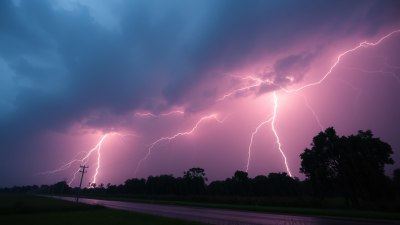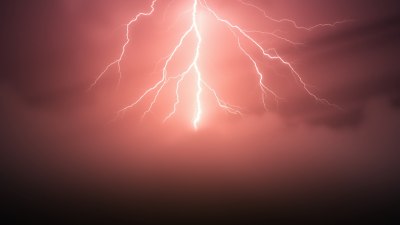The Surprising Neuroscience of Loving a Good Storm
Explore the fascinating neuroscience behind why many people find storms captivating and even comforting.

Image created with Flux Schnell
Thousands of years ago, human beings relied heavily on understanding and predicting weather patterns for survival. Storms, particularly intense ones, were not only potentially dangerous but also awe-inspiring events that commanded attention. For many people today, the rush of a thunderstorm or the hypnotic pulse of rain is far from frightening—it is instead a source of fascination and even comfort. But what is it about storms that captivates the human brain? The answer lies deep within our neurological wiring and evolutionary adaptations. This article delves into the surprising neuroscience behind why many individuals love a good storm.
Storms and the Human Brain: An Intriguing Connection
To understand the neuroscience behind our attraction to storms, it is essential to first recognize how the human brain processes sensory stimuli. Our brains are hardwired to prioritize novel, intense, or emotionally charged experiences. Storms bring a complex blend of sensory inputs: the low rumble of thunder, the erratic flashes of lightning, the rhythmic patter of rain, and sudden bursts of wind. These multi-sensory elements engage multiple brain regions, triggering heightened attention.
Neuroscientifically, the amygdala, a brain region involved in processing emotions, especially those related to fear and arousal, becomes active during thunderstorms. Yet, for many, this activation does not equate solely to fear; it often transitions into fascination or even exhilaration. This phenomenon suggests a nuanced neurological mechanism distinguishing between reactive fear and positive excitement toward storms.
The Role of the Limbic System in Storm Perception
The limbic system, comprising structures like the hippocampus, amygdala, and hypothalamus, governs emotional responses and memory processing. When exposed to storm stimuli, the amygdala interprets the sensory information and assesses threat levels based on past experiences and contextual cues. For those who associate storms with safety or positive memories, such as cozying up indoors, the amygdala may trigger feelings of calmness rather than alarm.
Furthermore, the hippocampus plays a critical role in contextualizing these experiences, helping the brain form associations between the current storm stimuli and previous memories. This contextualization can lead to a sense of comfort or nostalgia during storms. The hypothalamus, which controls stress hormone release, can also regulate the physiological response to storms, potentially reducing anxiety for certain individuals.
Evolutionary Perspectives: Why Do We Feel Drawn to Storms?
From an evolutionary standpoint, storms were both threats and signals for environmental change. Early humans needed to be alert during such events, but also sought shelter and opportunities for social bonding. The attraction to storms might be an adaptive trait—engaging our curiosity and fostering preparedness in the face of natural challenges.
Scientists propose that storm-related stimuli help activate a state akin to controlled arousal. This selective activation can sharpen cognitive functions, increasing alertness without triggering a full-blown fight or flight response. Essentially, loving a good storm could reflect a neurological balance between excitement and safety awareness, shaped by evolutionary pressures.
The Psychological Comfort of Storms: A Safe Fight-or-Flight?
Many individuals report feeling a comforting thrill during thunderstorms. Psychologically, storms may provide a controlled environment to experience and modulate fear. The phenomenon parallels why some people enjoy horror films or roller coasters: safe threats allow individuals to face vulnerabilities in a manageable context.
Neurotransmitter systems, such as those involving dopamine, are activated when experiencing controlled fear, contributing to the pleasurable aspects of storm appreciation. The release of endorphins during these times can also lead to mood elevation, creating a positive feedback loop that reinforces the fondness for storms.
Storm Sounds and Neuro-Relaxation
The soundscape of a storm plays a pivotal role in its neurological impact. Rain's steady rhythmic sound, known as white noise, can mask disruptive sounds, aiding relaxation and sleep. This calming effect engages the parasympathetic nervous system, promoting rest and reducing cortisol levels, the body's stress hormone.
Research shows that natural sounds like rainfall can enhance alpha brainwave activity, associated with relaxed wakefulness and reduced anxiety. This neuro-relaxation effect explains why many find the sound of rain or gentle thunder meditative, linking the sensory experience of storms to emotional well-being.
Lightning, Visual Stimuli, and Brain Activation
Lightning offers dramatically vivid visual input, activating the visual cortex and other brain areas associated with attention and memory. The unpredictability and intensity of lightning flashes stimulate neural pathways responsible for alertness and anticipation, providing an exhilarating cognitive experience.
Moreover, the contrast between the sudden brightness of lightning and the surrounding darkness enhances sensory processing and emotional engagement. This interplay may help explain why lightning captures and holds human attention so effectively in storms.
Neurochemical Responses to Storm Exposure
Exposure to storms triggers complex neurochemical cascades. The sympathetic nervous system initially initiates a mild stress response, elevating heart rate and releasing adrenaline. However, this response is often short-lived, especially in safe, indoor environments.
Subsequent activation of parasympathetic pathways helps restore balance, accompanied by secretion of serotonin and dopamine, neurotransmitters linked to mood regulation and pleasure. This neurochemical shift can transform a potentially stressful event into a deeply enjoyable experience.
Cultural and Individual Differences: Brain Plasticity at Work
Cultural attitudes toward storms and individual past experiences profoundly influence neural responses. In cultures where storms are viewed with reverence or as spiritual events, positive emotional associations form more readily, shaping neural responses toward appreciation rather than fear.
Additionally, brain plasticity allows repeated exposure to storms in a safe context to rewire fear circuits into pathways associated with pleasure and curiosity. This adaptation underscores the brain's remarkable ability to reshape emotional reactions based on context and learning.
Storms as a Gateway to Mindfulness and Presence
The immersive nature of storms naturally directs attention to the present moment, aligning with principles of mindfulness. Neural networks involved in focused attention become engaged during storms, as the brain processes complex sensory stimuli, limiting mind-wandering and enhancing awareness.
This mindful state, reinforced by calming neurochemical releases, may promote mental health benefits such as reduced anxiety and improved emotional regulation. Appreciating a storm can thus be an involuntary form of mindfulness encouraged by natural stimuli.
Practical Implications for Well-Being
Understanding the neuroscience behind storm appreciation suggests practical applications in mental health and relaxation techniques. Simulated rain sounds and storm imagery can be used therapeutically to induce calm states or aid sleep.
Furthermore, recognizing individual differences in response to storms can guide personalized interventions. For example, those prone to anxiety may benefit from gradual exposure to storm-related stimuli to rewire fearful neural circuits into more positive responses.
Technologies Inspired by Storm Neuroscience
Innovation in sound therapy and immersive virtual environments has drawn inspiration from storm sensory patterns. By replicating the multisensory inputs of storms, these technologies aim to harness the relaxing and stimulating effects of natural weather events for therapeutic purposes.
Such advancements reflect the deepening understanding of how storm-related neural mechanisms function, making nature-inspired treatments more accessible for stress relief and enhancing overall well-being.
Environmental and Psychological Intersections
The neuroscience of storm appreciation also highlights the complex relationship between environment and psychology. Storms serve as natural reminders of the Earth's power and unpredictability, fostering a sense of humility and connectedness often described as awe.
This emotional experience, linked to activation of brain regions involved in social cognition and self-transcendence, can promote psychological growth and resilience, illustrating the profound influence of natural phenomena on human mental states.
Future Directions: Research and Discoveries Ahead
The field of affective neuroscience continues to explore how natural stimuli like storms influence emotional and cognitive brain circuits. Future research, integrating neuroimaging and psychophysiology, is poised to uncover more detailed mechanisms underlying the fascination with storms and how these can be harnessed for mental health.
Continued study will also address the variability of storm responses across populations and developmental stages, potentially informing age-appropriate therapeutic applications and cultural adaptations.
The surprising neuroscience of loving a good storm reveals a rich tapestry of brain functions, neurochemical dynamics, evolutionary adaptations, and psychological benefits. The interaction between storm sensory experiences and the brain's complex emotional machinery underscores why many find these natural phenomena not only thrilling but also deeply comforting.
Whether drawn to the mesmerizing dance of lightning, the soothing cadence of rainfall, or the invigorating rumble of thunder, storm lovers embody a unique neural intertwining of curiosity, excitement, safety, and peace—an interplay that continues to inspire scientific inquiry and personal reflection alike.











